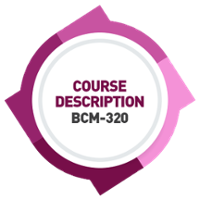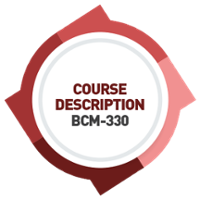Overview
![]() At this stage, you are about to attend the first WSQ BCM workshop organised in-house. It may be useful if you have not read the first two articles regarding how this project started, you may want to read "[1] Starting the Project" and "[2] Developing BCM Structure and Framework."
At this stage, you are about to attend the first WSQ BCM workshop organised in-house. It may be useful if you have not read the first two articles regarding how this project started, you may want to read "[1] Starting the Project" and "[2] Developing BCM Structure and Framework."
This article is the third part of the "WSQ Funded BCM Project" series. This is the reading for participants embarking on a BCM implementation using a combination of training with funding from the Singapore government and consulting to develop, implement and finalize its BCM program for an organisation.
This "Risk Analysis and Review" or "RAR" phase involved the "Running a risk assessment" using WSQ funded training entails the following steps.
1. Supplementary Readings
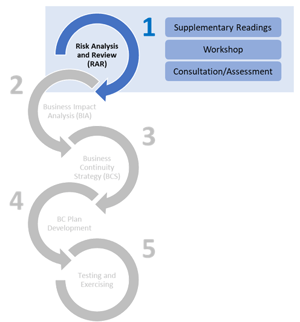 Participants will receive emails (similar to what you are reading now) containing bite-size information on risk assessment. The purpose of doing so is to introduce them to the key concepts ahead of the coming workshop. This helps participants optimize their time at the workshop.
Participants will receive emails (similar to what you are reading now) containing bite-size information on risk assessment. The purpose of doing so is to introduce them to the key concepts ahead of the coming workshop. This helps participants optimize their time at the workshop.
What should participants do:
Participants are encouraged to read through the supplementary material and write down any questions they may have.
2. Workshop [Onsite or Online]
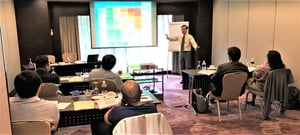 A workshop [onsite or online] will be conducted to guide project participants to identify, analyse and evaluate their risks. The consultant will also use this time to explain the more difficult concepts on risk. A set of templates is used to facilitate this process.
A workshop [onsite or online] will be conducted to guide project participants to identify, analyse and evaluate their risks. The consultant will also use this time to explain the more difficult concepts on risk. A set of templates is used to facilitate this process.
For the online workshop, participants will be put through an E-Learning program a week before the workshop itself, giving them the necessary information and context to understand some of the key concepts involved in Risk Analysis prior to the actual workshop session itself.
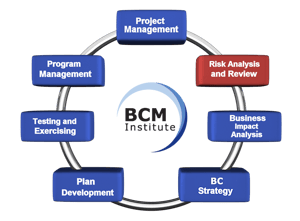
What participants should do for the Onsite Workshop:
- As the RAR is an important cornerstone of the business continuity planning process, participants are encouraged to read the email supplementary materials before the workshop.
- The softcopy RAR templates will be downloaded from eCampus by the participants before the workshop
- Participants should load the templates into their laptops and have them available during the workshop.
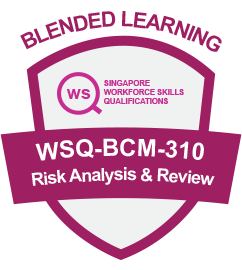 What participants should do for the Online Workshop:
What participants should do for the Online Workshop:
- Participants are encouraged to read the email supplementary materials before the workshop
- The softcopy RAR templates should be downloaded from the same E-Learning portal "eCampus"
- Participants should complete the E-Learning Module and begin filling in their templates
- Participants should then submit their completed templates
It is important to note that because the workshop is a 1-time group event, it is important that participants lock this event in their calendars. No repeat workshop will be conducted for absent participants and there is a possibility that SkillsFuture Singapore or SSG will not approve the course subsidy if the participant is absent for more than 75% of the module.
3. Consultation & Assessment [Onsite or Online]
After the workshop, participants will have one week to complete and submit the templates to their Organisation BCM Coordinator or often referred to as the BCM Manager. who will consolidate the templates and send the batch to the consultant?
A consultation and assessment session (approx. 30 mins) has been arranged for individual departments to go through the templates with the consultants and sit for a simple open-book assessment comprising a few easy-to-answer questions. This assessment is a requirement from SkillsFuture Singapore or SSG to qualify for government funding.
Assessment sessions can be conducted either face-to-face or online. In the event of the latter, Zoom will be used to facilitate the assessment between consultants and participants.
Refer to answer [3] to [6] provided in "FAQ on WSQ Courses Offered by BCM Institute" to have a better understanding of the expectation of a WSQ assessment.
What should participants do:
- Submit the risk assessment templates to your Organisational BCM Coordinator on time
- Before the consultation & assessment session, review your templates, and quickly read through the course materials
- Attend the consultation & assessment session at the appointed time
- If there are any changes required, submit a revised completed template to your Organisational BCM Coordinator.
What should participants do for Online classes:
- Submit the Risk Analysis template to the E-Learning portal prior to the instructor's session
- Prior to the consultation/assessment session, comments will be sent over via the E-Learning Portal. Participants are expected to make edits to their RAR template prior to the session
- Before the consultation & assessment session, review your templates, and quickly read through the course materials
- Attend the consultation & assessment session at the appointed time (on Zoom)
- Re-submit the final, revised template to the E-learning Portal
The consultant will process the templates from all departments and write a report for submission to the organisation's management.
Often, participants are worried about the assessment as they felt that they are taking an examination that they had taken in school. The concerns and the many other questions are answered in the "Frequently Asked Questions on WSQ Courses Offered by BCM Institute."
4. Public WSQ Course
The strength of this program is the continuity of BCM knowledge should there be a replacement to the officer responsible for BCM. If you are attending a public WSQ course, this course is similar to the morning session for the WSQ-BCM-310 (Course code) and it is titled "Assessing Risk and Business Impact Requirements"
Once this session is completed, you are now ready to attend the next "Business Impact Analysis" workshop to be held in the afternoon session. Sometimes, this session can be held separately due to time constraints from the participants.
Training-led BCM Implementation Roadmap



![[BL] [2] [RAR] WSQ Funded BCM Training and Project: Running the Risk Assessment](https://no-cache.hubspot.com/cta/default/3893111/b8cae5c7-407e-46e1-8ab7-e1dc0d1d6dd9.png)
![[BL] [4] [BCS] WSQ Funded BCM Training and Project: Evaluating the Business Continuity Strategy](https://no-cache.hubspot.com/cta/default/3893111/f1eca023-b7b6-4efd-b7c2-bb5301b3845e.png)
![[BL] [6] [TE] WSQ Funded BCM Training and Project: Executing Tests and Exercises](https://no-cache.hubspot.com/cta/default/3893111/59457891-68bd-4e23-ab1e-44d793c03e28.png)
![[BL] [3] [BIA]: WSQ Funded BCM Training and Project: Executing the Business Impact Analysis](https://no-cache.hubspot.com/cta/default/3893111/5ad02a1f-0b6e-4b06-a285-036955b14572.png)
![[BL] [5] [PD] WSQ Funded BCM Training and Project: Implementing the Business Continuity Plan](https://no-cache.hubspot.com/cta/default/3893111/f83c215b-a30e-4620-8dbf-de639267f5f3.png)





